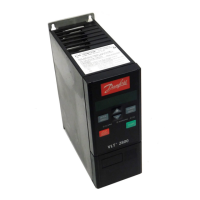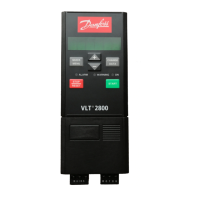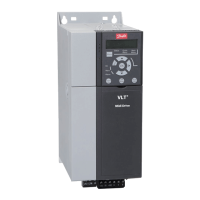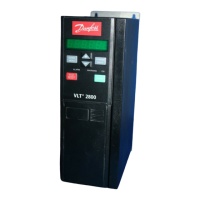Function:
Initial voltage is active for the time set in parameter 120
Start delay , after a start command. This parameter can
be used for example for lifting/dropping applications
(conical anchor motors).
Description of choice:
Set the required voltage necessary to cut out the me-
chanical brake. It is assumed that parameter 121 Start
function, is set to Start frequency/voltage clockwise [3]
or Start frequency/voltage in reference direction [4] and
that in parameter 120 Start delay a time is set, and that
a reference signal is present.
132 DC brake voltage
(DC BRAKE VOLTAGE)
Value:
0 - 100% of max. DC brake voltage
0%
Function:
In this parameter, the DC brake voltage is set which is
to be activated at stop when the DC brake frequency
set in parameter 127 DC brake cut-in frequency is
reached, or if DC braking inverse is active via a digital
input or via serial communication. Subsequently, the
DC brake voltage will be active for the time set in pa-
rameter 126 DC brake time.
Description of choice:
To be set as a percentage value of the max. DC brake
voltage, which depends on the motor.
133 Start voltage
(START VOLTAGE)
Value:
0.00 - 100.00 V
Depends on unit
Function:
A higher start torque can be obtained by increasing the
start voltage. Small motors (< 1.0 HP) normally require
a high start voltage.
Description of choice:
The factory setting will be suitable for must applica-
tions, the value may need to be increase gradually for
high torque application.
Warning: If the use of start voltage is ex-
aggerated, this may lead to over-energiz-
ing and overheating of the motor and the
variable frequency drive may cut out.
134 Load compensation
(LOAD COMPENSATIO)
Value:
0.0 - 300.0%
100.0%
Function:
In this parameter, the load characteristic is set. By in-
creasing the load compensation, the motor is given an
extra voltage and frequency supplement at increasing
loads. This is used e.g. in motors/applications in which
there is a big difference between the full-load current
and idle-load current of the motor.
NOTE
If this value is set too high, the variable
frequency drive may cut out because of
overcurrent.
Description of choice:
If the factory setting is not adequate, load compensa-
tion must be set to enable the motor to start at the given
load.
Warning: Should be set to 0% in connec-
tion with synchronous and parallel-cou-
pled motors and in the case of quick load
changes. Too high load compensation
may lead to instability.
VLT
®
2800 Series
= factory setting, () = display text, [] = value for use in communication via serial communication port
48 MG.27.A2.22 - VLT
®
is a registered Danfoss trademark

